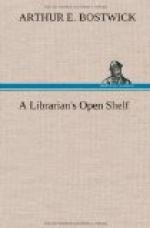A curious fact is that the tendency to attempt to “begin at the beginning” is so strong that it sometimes extends to collected works in which there is no sequence from volume to volume. Thus we have the following:
Vol.
Vol. Vol. Vol. Vol. Vol.
I.
II. III. IV. V. VI.
Chaucer, “Poetical Works” 38 9 5 Milton, “Poetical Works” 19 8 Longfellow, “Poetical Works” 14 15 2 10 3 3 Emerson, “Essays” 48 13 Ward, “English Poets” 13 2 6
There are of course exceptions to the rule that circulation decreases steadily from volume to volume. Here are a few:
Vol.
Vol. Vol. Vol.
I. II.
III. IV.
Fiske, “Old Virginia” 26 24 Spears, “History of the Navy” 44 39 36 36 Andrews, “Last Quarter Century” 8 8 Kennan, “Siberia” 15 13
In the case of the two-volume works the interest-sustaining power may not always be as great as would appear, because when the reader desires it, two volumes are given out as one; but the stamps on the dating-slips show that this fact counted for little in the present instances.
I would not assume that the inferences in the present article are of any special value. The statistical facts are the thing. So far as I know, no one has called attention to them before, and they are certainly worthy of all interest and attention.
WHAT MAKES PEOPLE READ?
Does the reading public read because it has a literary taste or for some other reason? In the case of the public library, for instance, does a man start with an overwhelming desire to read or study books and is he impelled thereby to seek out the place where he may most easily and best obtain them? Or is he primarily attracted to the library by some other consideration, his love for books and reading acting only in a secondary manner? The New York Public Library, for instance, carries on the registry books of its circulating department nearly 400,000 names, and in the course of a year nearly 35,000 new applications are made for the use of its branch libraries, scattered over different parts of the city. What brings these people to the library? This is no idle question. The number of library users, large as it is, represents too small a fraction of our population. If it is a good thing to provide free reading matter for our people—and every large city in the country has committed itself to the truth of this proposition—we should certainly try to see that what we furnish is used by all who need it. Hence an examination into the motives that induce people to make their first use of a free public library may bring out information that is not only interesting but useful. To this end several hundred regular users of the branches of the New York Public Library were recently asked this question directly, and the answers are tabulated and discussed below. In each of sixteen branch libraries the persons interrogated numbered forty—ten each of men, women, boys and girls. Thirty answers have been thrown out for irrelevancy or defectiveness. The others are classified in the following table:




